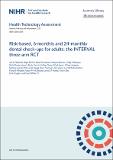Risk-based, 6-monthly and 24-monthly dental check-ups for adults : the INTERVAL three-arm RCT
Abstract
Background: Traditionally, patients are encouraged to attend dental recall appointments at regular 6-month intervals, irrespective of their risk of developing dental disease. Stakeholders lack evidence of the relative effectiveness and cost-effectiveness of different recall strategies and the optimal recall interval for maintenance of oral health. Objectives: To test effectiveness and assess the cost-benefit of different dental recall intervals over a 4-year period. Design: Multicentre, parallel-group, randomised controlled trial with blinded clinical outcome assessment at 4 years and a within-trial cost-benefit analysis. NHS and participant perspective costs were combined with benefits estimated from a general population discrete choice experiment. A two-stratum trial design was used, with participants randomised to the 24-month interval if the recruiting dentist considered them clinically suitable. Participants ineligible for 24-month recall were randomised to a risk-based or 6-month recall interval. Setting: UK primary care dental practices. Participants: Adult, dentate, NHS patients who had visited their dentist in the previous 2 years. Interventions: Participants were randomised to attend for a dental check-up at one of three dental recall intervals: 6-month, risk-based or 24-month recall. Main outcomes: Clinical - gingival bleeding on probing; patient - oral health-related quality of life; economic - three analysis frameworks: (1) incremental cost per quality-adjusted life-year gained, (2) incremental net (societal) benefit and (3) incremental net (dental health) benefit. Results: A total of 2372 participants were recruited from 51 dental practices; 648 participants were eligible for the 24-month recall stratum and 1724 participants were ineligible. There was no evidence of a significant difference in the mean percentage of sites with gingival bleeding between intervention arms in any comparison. For the eligible for 24-month recall stratum: the 24-month (n = 138) versus 6-month group (n = 135) had an adjusted mean difference of -0.91 (95% confidence interval -5.02 to 3.20); the risk-based (n = 143) versus 6-month group had an adjusted mean difference of -0.98 (95% confidence interval -5.05 to 3.09); the 24-month versus risk-based group had an adjusted mean difference of 0.07 (95% confidence interval -3.99 to 4.12). For the overall sample, the risk-based (n = 749) versus 6-month (n = 737) adjusted mean difference was 0.78 (95% confidence interval -1.17 to 2.72). There was no evidence of a difference in oral health-related quality of life between intervention arms in any comparison. For the economic evaluation, under framework 1 (cost per quality-adjusted life-year) the results were highly uncertain, and it was not possible to identify the optimal recall strategy. Under framework 2 (net societal benefit), 6-month recalls were the most efficient strategy with a probability of positive net benefit ranging from 78% to 100% across the eligible and combined strata, with findings driven by the high value placed on more frequent recall services in the discrete choice experiment. Under framework 3 (net dental health benefit), 24-month recalls were the most likely strategy to deliver positive net (dental health) benefit among those eligible for 24-month recall, with a probability of positive net benefit ranging from 65% to 99%. For the combined group, the optimal strategy was less clear. Risk-based recalls were more likely to be the most efficient recall strategy in scenarios where the costing perspective was widened to include participant-incurred costs, and in the Scottish subgroup. Limitations: Information regarding factors considered by dentists to inform the risk-based interval and the interaction with patients to determine risk and agree the interval were not collected. Conclusions: Over a 4-year period, we found no evidence of a difference in oral health for participants allocated to a 6-month or a risk-based recall interval, nor between a 24-month, 6-month or risk-based recall interval for participants eligible for a 24-month recall. However, people greatly value and are willing to pay for frequent dental check-ups; therefore, the most efficient recall strategy depends on the scope of the cost and benefit valuation that decision-makers wish to consider. Future work: Assessment of the impact of risk assessment tools in informing risk-based interval decision-making and techniques for communicating a variable recall interval to patients.
Citation
Clarkson , J E , Pitts , N B , Goulao , B , Boyers , D , Ramsay , C R , Floate , R , Braid , H J , Fee , P A , Ord , F S , Worthington , H V , van der Pol , M , Young , L , Freeman , R , Gouick , J , Humphris , G M , Mitchell , F E , McDonald , A M , Norrie , J DT , Sim , K , Douglas , G & Ricketts , D 2020 , ' Risk-based, 6-monthly and 24-monthly dental check-ups for adults : the INTERVAL three-arm RCT ' , Health Technology Assessment , vol. 24 , no. 60 , pp. 1-138 . https://doi.org/10.3310/hta24600
Publication
Health Technology Assessment
Status
Peer reviewed
ISSN
1366-5278Type
Journal article
Description
Funding: This project was funded by the National Institute for Health Research (NIHR) Health Technology Assessment programme [project numbers 06/35/05 (Phase I) and 06/35/99 (Phase II).Collections
Items in the St Andrews Research Repository are protected by copyright, with all rights reserved, unless otherwise indicated.

